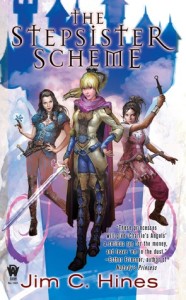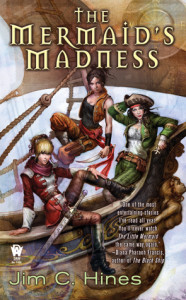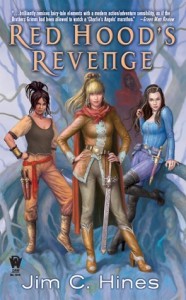The Stepsister Scheme
Jim C. Hines is honestly one of my favorite authors, even though he’s never written a book that I’ve lost my mind* over. What he writes is solid, fun fantasy with a strong feminist backbone. He also seems to have a thing for championing the underdog, and writing stories that subvert traditional story-types. The Princess series, of which I’ve read all but the last book at the time of writing this review, is particularly notable as all the main characters are ladies, and a significant part of the narrative involves Hines re-framing fairy-tale narratives to give agency back to their heroines.
*Although, I do have high hopes for the forthcoming Revisionary, since the third Magic Ex Libris book was SO CLOSE to being perfect.
The Stepsister Scheme has two main narrative goals: set up the world and the characters so that Hines can play around in it in books two and three, and to turn the Cinderella story on its head. He does both with the introduction of his Cinderella, whose name is Danielle Whiteshore (formerly Danielle de Glas–her deceased father was a renowned glassblower). Danielle is having a hard time adjusting to life as a royal (she identifies more with the servants than the nobles), and then her stepsister tries to kill her using newly acquired magic, and which ultimately leads to the kidnapping of her prince, Armand. This brings Snow (Snow White) and Talia (Sleeping Beauty) into her life. Both young women have been living at the palace incognito as the Queen’s special “bodyguards,” all the while secretly helping her spy and take out threats in a more covert way. Both ladies are living in exile from their own kingdoms, Snow taking refuge from the political chaos the murder of her mother the Evil Queen caused, and Talia because basically Hines went all the way back to the original Sleeping Beauty story which is FUCKED UP, and I don’t want to say any more than that here because spoilers. (Will say more in my review of Red Hood’s Revenge.)
I pretty much fell in love with Talia and Snow immediately upon meeting them, but this is really Danielle’s book. She insists on accompanying Talia and Snow to fairyland and back in order to rescue her prince. It’s also here that she takes back her own story. The fact that she fell in love and married Armand in the space of a month, and the whole thing with the glass slipper, makes sense simply because Hines takes the time to flesh out Danielle and make her into a real person. Plus, he also gives her the beyond cool magical power of being able to talk to animals and persuade them to help her. She also proves very intelligent when dealing with the fairies, who are notoriously tricky, and she manages to save the day without compromising her kind heart and compassionate spirit.
I zoomed through the first three books in this series in a period of four days, so you know it’s gotta be a fun time. If you’re at all susceptible to fairy-tale retellings, check this series out.
The Mermaid’s Madness
My initial reaction to The Mermaid’s Madness was that it wasn’t as fun as the first book, probably because the novelty might have worn off, but also because the main emotional conflict in the story happens on a character we barely spend any time with. And I definitely agree with the latter statement, but not the first. This book is the weakest of the three I’ve read so far, simply because none of our three ladies have any true personal stakes in what’s going on. There is absolutely no novelty at work in the next book in the series, and it’s by far the best.
The plot is in the title with this one, as Hines does his take on “The Little Mermaid,” drawing as his main inspiration the original Hans Christian Andersen tale, although Hines’ version is significantly darker than the original, which is saying something, because that story is already about a girl who falls in love with a man who lives in a world she can never be part of, and after sacrificing her voice literally and figuratively, and enduring great pain to be with him, ends up killing herself to save him despite that he dumps her for some other asshole. And wooohooo she’s rewarded with a soul! Except that’s balls. All of those elements are present in this book, but they’re twisted just enough so you can’t see what’s coming around the next narrative bend.
Anyway, so Hines’ little mermaid, Lirea (an anagram for Ariel, doncha know) opens the book by attacking Queen Beatrice, who is the princesses’ protector and mentor, so they go all out in trying to track the foul merbeast down and save the life of their queen. It’s a lot more complicated than that, but spoilers, so oh well.
I found the story intellectually interesting, and Hines’ version of the Little Mermaid story was sort of fun, if very sad also, but I found myself mostly emotionally disengaged from it. Books one, three and four (I assume–again, haven’t read the last one yet) directly engage with each princess’s backstory, and the emotional stakes are ridiculously high (especially in book three). I think this book would have been so much better if Hines had given more narrative POV time to the actual mermaid in the story, instead of having her sort of be a sideshow in her own story (which turns out to be very tragic). It’s not that Hines takes away her agency, because I think mostly the distance we have from her is a function of preserving the twists and turns in the story, but that hers was the most interesting emotional journey in the book, and it’s one we get almost nothing of. Of the three main princesses, Snow gets the meatiest storyline as the mermaid (here called undine) sea witch begins to teach her to hone her magical powers, but it’s still not that significant compared to the other books. Snow, Talia and Danielle are also fighting to save Quean Bea, but it’s more of a removed conflict, especially since we never believe for a second that she won’t survive.
Anyway, I liked it, but it could have been better.
Red Hood’s Revenge
Oh, man, I loved this one. It’s the best book in the series so far, and it follows the best character in the series. Spoilers for books one and two unavoidable in the paragraphs to follow.
Talia Malak-el-Dahshat, aka Sleeping Beauty, is by far the most conflicted and complicated character in this series, and it’s her fairy-tale past we get to dive into this time. Talia carries around the emotional trauma of her past and wears it like armor. Talia’s time as a fairy-tale princess is a cruel joke–even in the world of the story, her experiences have been reduced to a romanticized story. The most beautiful, athletic, graceful princess in the world, cursed to sleep for one hundred years, sought after by hundreds of princes, whose sleep brought about massive changes in her country’s political system, and the uprising of the fairies, who was woken by a handsome prince and married him.
But even if the tales stop there, Talia’s life doesn’t. And the tales certainly don’t mention how her wonderful prince raped her as she slept, and that she wasn’t awoken by a kiss, but by the pangs of labor as her twin children were born. They don’t mention how she murdered her rapist, after being forced to marry him, and escaped to take refuge in another kingdom, abandoning her homeland to be ruled by the people who killed her entire family, and who are now raising her children to hate her.
Oh, man, you guys. That is some meaty shit to work with, and Hines works it for all he’s worth. Talia finally confronting her past is a wonderful reading experience, and the way he has her react, taking back her power and re-writing the story so that the injustices done to her are made plain is just genius.
I also loved loved loved what he did with the Arabian inspired fairy-tale world that she comes from. The desert setting is so evocative, and the way Talia navigates it like a boss is so much fun, reclaiming her power and moving on from all that trauma that happened to her.
Also, SPOILERS she’s a lesbian! LGBT all up in my fairy-tales! Themes of people rejecting toxic masculinity and violence are my bread and butter! END SPOILERS.
Plus, there’s this whole thing with Red Hood, who in Hines’ world is a famous assassin bent on avenging the deaths of her family at the hands of the fairies when she was a child. She and Talia make a fantastic team, and the way her storyline wraps up is pretty much awesome, even if it’s kind of sad at the same time.
This book was awesome. It totally makes up for how lackluster book two was, and I can’t wait to see what happens in the final book.



